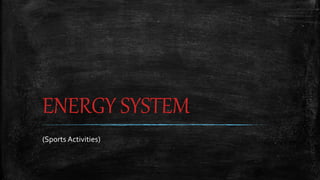
ENERGY SYSTEM-12.pptx
- 4. ▪WHAT IS ENERGY? The ability to do work ▪WHAT IS SYSTEM? A set of connected things
- 5. THREE ENERGY SYSTEM 1. ATP – PC = Anaerobic Alactic Energy System, High Intensity-Short Duration 2. LACTICACID SYSTEM = Anaerobic Lactic (Glycolysis) Energy System, High to Medium Intensity 3. OXIDATIVE = Aerobic Energy System, Low intensity-Long Duration-Endurance
- 6. A. The Immediate Energy System This system refers to ATP-CP or Adenosine Triphosphate-Creatine Phosphate. It is called the immediate energy system where it is the first system that can be use when doing an activity. It does not require oxygen (anaerobic) and it does not produce lactate (as with glycolysis). Instead, the system involves ATP and Creatine Phosphate that are stored within the muscle fibers.
- 7. Ex. ▪ Athletes who compete in sports that require high amounts of short duration acceleration
- 8. B. The Glycolytic System (Anaerobic) ▪ The Glycolysis is the pathway that splits carbohydrate (glucose or stored glycogen) in order to generate ATP to power cellular work. ▪ This is the second in line to contribute for energy production. This system works during short-duration, high-intensity exercises or dances. This is also called as the Anaerobic Lactic System
- 9. ▪ The anaerobic lactic (AL) system (also known as fast glycolysis) provides energy for medium to high intensity bursts of activity that lasts from ten seconds to two minutes. Some American football skill positions, baseball players, soccer players, judokas, middle distance runners (400m-800m) and sprinters rely on this system. ▪ The anaerobic lactic system, as well as the ATP-CP system, are capable of high intensity levels, and do not rely on oxygen for fuel.
- 10. C. Metabolic response to exercise influence of Duration and Intensity. a.) Intense exercise lasting more than twenty seconds relies more on anaerobic glycolysis to produce much of the neededATP. b.) High-intensity events lasting longer than forty- five seconds use a combination of ATP-PC, glycolysis and the aerobic system to produce the neededATP. c.)The energy to perform prolonged exercise (ex.10mins comes primarily from aerobic metabolism)
- 11. C. The Oxidative System (Aerobic) ▪ The aerobic system is the most utilized of the three. It provides energy for low intensity activities that last anywhere from two minutes to a few hours. ▪ Unlike the other two systems, the aerobic system requires oxygen and takes much longer to overload. Sports and activities that use continuous sustained efforts such as long-distance swimming, crew (rowing) and sea kayaking rely on the aerobic system.
- 12. The energy system of our body works in different ways in which it generates fuel and uses it as an energy to perform a certain task.
- 13. ▪We all know that in able for our body to work, all we must do is to eat. The food that we eat gives as the energy to do work and to accomplish something. These food serves as the fuel of our body.
- 14. 1. Interaction of Energy System ShortTerm High Intensity Activities • Contribution ofAnaerobic ATP production is greater. Example: 100 meter dash ShortTerm High Intensity Activities • Contribution ofAerobic ATP production for the bulk of the needed energy is greater. Example: Marathon or Long distance swimming GENERALIZATION: The shorter the duration of all-out activity, the greater the contribution of anaerobic production; conversely, the longer the duration, the greater the contribution of aerobic energy production
- 15. 2. Exercise Metabolism ▪ Exercises pose a serious challenge to the biogenetics pathways in the working muscle. During heavy exercises the body’s total energy expenditure may increase 15-25 times at rest which may increase energy utilization 200 times over utilization at rest. Skeletal muscles have a great capacity to produce and used large quantities of ATP during exercise.
- 16. A. Rest to Exercise a.)Within one step in treadmill (running at 6mph) the muscle must increase their rate of ATP production from that required for standing. b.) 0xygen Consumption increase instantaneously to steady state within 1-4 minutes. c.) oxygen consumption does not increase instantaneously to a steady value.
- 17. B. Recovery from exercise a.) Metabolism remains elevated for several minutes immediately following exercise. b.)The magnitude and duration of this elevated metabolism is influenced by the intensity of exercise. c.)The oxygen uptake is greater and remains elevated for a longer time period following high-intensity exercise when compared to exercise of light-to-moderate intensity
- 18. D. Factors Governing Fuel Selection a.) Regulation of fuel selection during exercise is dependent on several factors including diet and the intensity of exercise. b.) In general, carbohydrates are used as the major fuel source during high intensity exercise. c.) During prolonged exercise, there is a gradual shift from carbohydrates metabolism towards fat metabolism. d.) Protein contributes less than 2% of the fuel used during exercise of less than hour duration. During prolonged exercise (3- 5hrs duration), the total contribution of protein to the fuel supply
- 19. Activity 1 List down at least 5 activities that requires the following Energy Systems; ATP-PC GLYCOLYTIC OXIDATIVE 1. 1. 1. 2. 2. 2. 3. 3. 3. 4. 4. 4. 5. 5. 5.